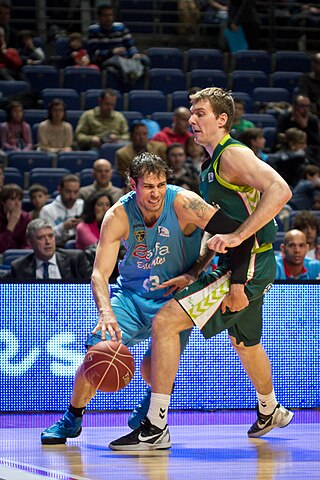Related Research Articles

The point guard (PG), also called the one or the point, is one of the five positions in a regulation basketball game. A point guard has perhaps the most specialized role of any position. Point guards are expected to run the team's offense by controlling the ball and making sure that it gets to the right player at the right time. Above all, the point guard must understand and accept their coach's game plan; in this way, the position can be compared to a quarterback in American football. They must also be able to adapt to what the defense is allowing and must control the pace of the game.
The triangle offense is an offensive strategy used in basketball. Its basic ideas were initially established by Hall of Fame coach Sam Barry at the University of Southern California. His system was further developed by former Houston Rockets and Kansas State University basketball head coach Tex Winter, who played for Barry in the late 1940s. Winter later served as an assistant coach for the Chicago Bulls in the 1980s and 1990s and for the Los Angeles Lakers in the 2000s, mostly under head coach Phil Jackson.

In basketball, a personal foul is a breach of the rules that concerns illegal personal contact with an opponent. It is the most common type of foul in basketball. A player fouls out on reaching a limit on personal fouls for the game and is disqualified from participation in the remainder of the game.
The Princeton offense is an offensive basketball strategy which emphasizes constant motion, back-door cuts, picks on and off the ball, and disciplined teamwork. It was used and perfected at Princeton University by Pete Carril, though its roots may be traced back to Franklin “Cappy” Cappon, who coached Princeton in the late 1930s, and Bernard "Red" Sarachek, who coached at Yeshiva University from 1938 to 1977.

The pick and roll in basketball is an offensive play in which a player sets a screen (pick) for a teammate handling the ball and then moves toward the basket (rolls) to receive a pass. In the NBA, the play came into vogue in the 1990s and has developed into the league's most common offensive action. There are, however, many ways in which the defense can also counter the offensive screen.

In basketball, there are five players that play per team, each assigned to positions. Historically, these players have been assigned to positions defined by the role they play on the court, from a strategic point of view. The three main positions are guard, forward, and center, with the standard team featuring two guards, two forwards, and a center. Over time, as more specialized roles developed, each of the guards and forwards came to be differentiated, and today each of the five positions is known by a unique name and number: point guard (PG) or 1, the shooting guard (SG) or 2, the small forward (SF) or 3, the power forward (PF) or 4, and the center (C) or 5.
Zone defense is a type of defense, used in team sports, which is the alternative to man-to-man defense; instead of each player guarding a corresponding player on the other team, each defensive player is given an area to cover.
Basketball moves are generally individual actions used by players in basketball to pass by defenders to gain access to the basket or to get a clean pass to a teammate to score.

This glossary of basketball terms is a list of definitions of terms used in the game of basketball. Like any other major sport, basketball features its own extensive vocabulary of unique words and phrases used by players, coaches, sports journalists, commentators, and fans.
The Flex offense is an offensive strategy in basketball invented in 1967 by Rene Herrerias while coaching at Cal-Berkeley. It was utilized to bring UCLA's star center, Lew Alcindor, away from the basketball. The offense was originally called the "Cha Cha". It is a patterned offense relying on cuts across the key and down screens to create a "pick-the-picker" action. This offense is most effective against a man-to-man defense, though some ambitious coaches have used it against odd front zones. It is the favored offense of many high school programs because it requires players to be in constant motion and the patterns of screens and cuts are easy to remember. Though dismissed by many coaches at the college level for its predictability, some notable programs still rely on it. It has been run by many NCAA teams, including by Gary Williams of the University of Maryland. Williams used the flex offense to lead the Terrapins to the 2002 NCAA National Championship. Also, Gordie James of Willamette University used the flex offense to lead the Bearcats to the 1993 NAIA Division II National Championship. Additionally, Jerry Sloan ran his variation of it for years with the Utah Jazz.
The following terms are used in water polo. Rules below reflect the latest FINA Water Polo Rules.

The key, officially referred to as the free throw lane by the National Basketball Association (NBA), the National Collegiate Athletic Association (NCAA), the National Association of Intercollegiate Athletics (NAIA), and the National Federation of State High School Associations (NFHS), and the restricted area by the International Basketball Federation (FIBA) is a marked area on a basketball court surrounding the basket, where much of the game's action takes place.
The dribble drive motion is an offensive strategy in basketball, developed by former Pepperdine head coach Vance Walberg during his time as a California high school coach and at Fresno City College.
The following terms are used in American football, both conventional and indoor. Some of these terms are also in use in Canadian football; for a list of terms unique to that code, see Glossary of Canadian football.

The 1–3–1 defense and offense is a popular strategy used in basketball.

The 2–3 zone defense is a defensive strategy used in basketball as an alternative to man-to-man defense. It is referred to as the 2–3 because of its formation on the court, which consists of two players at the front of the defense and three players behind.
The amoeba defense is a defensive strategy in the game of basketball.
Basketball is a ball game and team sport in which two teams of five players try to score points by throwing or "shooting" a ball through the top of a basketball hoop while following a set of rules. Since being developed by James Naismith as a non-contact game that almost anyone can play, basketball has undergone many different rule variations, eventually evolving into the NBA-style game known today. Basketball is one of the most popular and widely viewed sports in the world.
Wheel offense is an offensive strategy in basketball, developed in the late 1950s by Garland F. Pinholster at the Oglethorpe University. It is a kind of continuity offense in which players move around in a circular pattern to create good scoring opportunities. The wheel offense is a popular offensive play, frequently used by teams from middle school to college levels because it can effectively work against any defense, including zone defense and man-to-man defense.
The Blocker-Mover or Wheel offense is an offensive scheme used in basketball, primarily, college basketball. The offense was popularized by Dick Bennett when he was the coach at Wisconsin-Green Bay, Wisconsin, and Washington State.
References
- ↑ Walker, Jeff. "Knight Developed Motion Offense Through Research, And He's Always Adapting". Avalanche-Journal. Archived from the original on January 27, 2015. Retrieved June 12, 2016.
